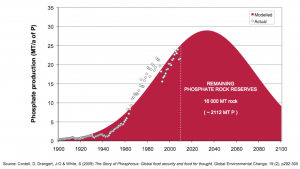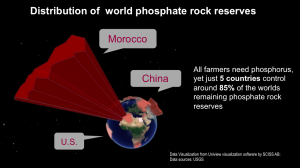Are we at the risk of global starvation? Scientists at the Global Phosphorus Research Initiative predict that in 30-40 years, there won’t be enough mined phosphorus to feed the planet.
Nations around the world have committed to ensuring food security in alignment with UN Sustainable Development and Millennium Development goals. Exponential population growth, evolution of societal food habits, disproportionate fertilizer usage and absence of phosphorous recycling practices from organic waste has diminished our supply and put us at risk of a global food scarcity.

Phosphorus Rock Remaining Image Credits: Phosphorus Futures
From the composition of your DNA and bones to plant biomass, this overlooked element is a vital ingredient for survival of organisms.
Phosphorous based fertilizers sparked the “Green Revolution”, which improved crop yields to feed the 4.2 billion population rise since 1950. The global demand for phosphorus is forecasted to rise by 50-100%.
Alterations in food habits such as increased preference of dairy and meat-based diets over plant material, has put a strain on phosphorus demands. Studies show that livestock requires double the phosphorus for plant fecundation.
Historically, phosphorus enriched human detritus, decaying plant matter and manure was an added stimulant for crop yields. Urbanization and innovation of household flush toilets meant human excreta was now disposed in water bodies and waste facilities.

Distribution of World Phosphorous Image credits : Phosphorous Futures
Currently, the dominant reserves of phosphorous are exclusive to US, China, Morocco, Jordan and South Africa, leaving the mineral trade subject to international and geopolitical influences.
China has levied 135% duty on its phosphorus exports to secure its own domestic supply of the mineral. Morocco is subject to sanctions due to its transgressions of human rights. USA’s primary reserves in California are projected to dry up in approximately 30 years, whereas western European nations and India are utterly devoid of the element, forcing all three regions to heavily rely on imports.
An integrated global effort is imperative to resolve the phosphate scarcity.
Urbanization has birthed population dense cities brimming with phosphorus hotbeds since humans excrete nearly 100% of the phosphorus they consume, yet, only 10% of the waste is recirculated for fecundation. Government initiatives are in motion in European countries and China to extract the mineral from sewage treatment facilities.
Furthermore, only 50% of phosphorous produced by animal waste and 40% of food residues is agriculturally recirculated. There is increasing movement to minimize phosphorus losses by recycling plant and animal byproducts for soil nourishment.
Societal changes in food habits, such as ingesting more plant intensive diets and diminishing food wastage, are crucial in avoiding the impending calamity of food insecurity.
Video attributes: https://www.youtube.com/watch?v=Y17HqUsaoj8
References
Elser, J; White, S. Peak Phosphorus, and Why It Matters. Foreign Policy. 2010
Cordell, D.; Drangert, J.-O.; White, S. Global Environmental Change 2009, 19 (2), 292–305.
